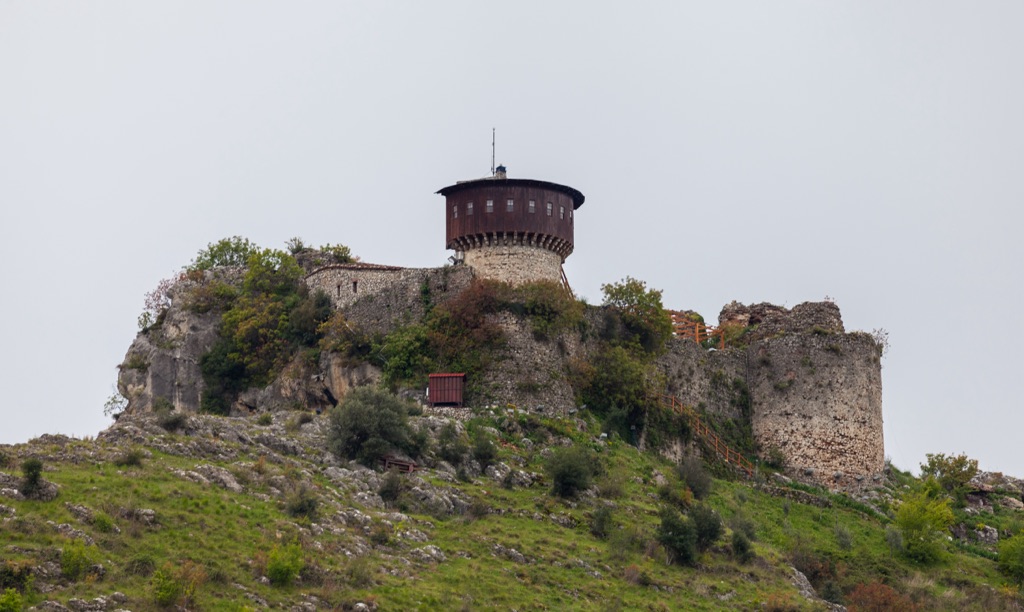Perched on a rocky hill overlooking the Erzen valley in Albania, Petrelë Castle is a historical fortress with roots dating back to the 6th century. Its strategic location has made it a significant military stronghold throughout history. The castle is known for its distinctive tower, which has become a symbol of the area. Over the centuries, Petrelë Castle has witnessed numerous battles and has been a silent spectator to the ebb and flow of empires. Today, it stands as a testament to Albania’s rich and tumultuous past, attracting visitors from around the world.
Get your dose of History via Email
Historical Background of Petrelë Castle
The discovery of Petrelë Castle is not attributed to a single event or person. Instead, it has been a part of Albanian consciousness for centuries. The castle’s origins trace back to the Byzantine era, specifically to the 6th century. It was built as a defense mechanism against invasions. The castle’s strategic importance grew, especially during the 15th century, under the rule of the Ottoman Empire.
The Petrelë Castle was constructed by Justinian I, a Byzantine Emperor known for his extensive building projects. Its primary purpose was to serve as a lookout and to protect the trade routes. The castle’s design and construction techniques reflect the military architecture of the time. It has undergone several renovations and expansions over the centuries.
Throughout its history, Petrelë Castle has seen various inhabitants and conquerors. Notably, the castle was under the control of the Thopia family during the Middle Ages. They were an Albanian noble family who played a significant role in the country’s history. The castle has also been the scene of many historical events, including battles and sieges that shaped the region’s history.
One of the most famous inhabitants of the castle was Skanderbeg, a national hero in Albania. He used Petrelë Castle as one of his main fortresses in the resistance against the Ottoman Empire. The castle’s role in these historical events has cemented its place in Albanian cultural heritage.
Despite its age, Petrelë Castle remains relatively well-preserved. It stands as a historical monument, offering insights into Albania’s feudal past. The castle’s history is not just about the stones and mortar; it’s about the people who built it, lived in it, and fought for it. It’s a story of resilience and endurance through the ages.
About Petrelë Castle
Petrelë Castle’s architecture is a testament to its military origins. The fortress is built on a rocky outcrop, providing a natural defense. Its most prominent feature is the three-story tower, which offers panoramic views of the surrounding landscape. The tower’s design is typical of the 15th-century military structures in the region.
The castle’s construction involved large stone blocks, expertly fitted together without the use of mortar. This technique is characteristic of Byzantine fortifications. Over time, the castle has been reinforced and expanded, reflecting the changing needs of its occupants.
Architectural highlights of Petrelë Castle include its defensive walls, which still stand today. The walls are punctuated by small windows that were used for archery. Inside the castle, one can find the remains of various structures, including a chapel and living quarters.
The methods of construction and building materials used in Petrelë Castle are indicative of the era’s engineering skills. The castle’s layout was designed to maximize defense capabilities. It includes a main gate that is strategically placed to be easily defendable.
Despite the wear of time, Petrelë Castle continues to impress visitors with its robust construction and architectural beauty. The fortress is a fine example of medieval Albanian architecture, with its blend of practicality and aesthetic appeal. It remains a proud symbol of Albania’s historical and cultural landscape.
Theories and Interpretations
Several theories surround Petrelë Castle, particularly regarding its use throughout history. It is widely accepted that the castle served military purposes. However, some suggest it may have also been a residence for nobility or a place of refuge.
The mysteries of Petrelë Castle include the exact purposes of certain architectural features. For example, some rooms and their functions are still a subject of speculation. Historians match these features to historical records to gain a better understanding of daily life in the castle.
Dating Petrelë Castle has been carried out using various methods. These include architectural analysis and historical documentation. The consensus places the original construction in the Byzantine period, with subsequent additions in the Middle Ages.
The castle’s history is not without gaps, and archaeologists continue to interpret new findings. Excavations and studies provide a clearer picture of the castle’s evolution over time. Each discovery adds a piece to the puzzle of Petrelë Castle’s past.
Despite the ongoing research, Petrelë Castle retains an air of mystery. Its walls hold stories that are yet to be fully uncovered. The castle is a living history book, inviting scholars and visitors alike to delve into its secrets.
At a glance
Country: Albania
Civilization: Byzantine Empire, later inhabited by Albanian nobility
Age: Origins date back to the 6th century AD
Conclusion and Sources
The information in this article has been obtained from the following reputable sources:
- Wikipedia – Petrelë Castle
- Encyclopædia Britannica
- World History Encyclopedia
- UNESCO World Heritage Centre
“`

